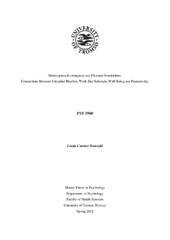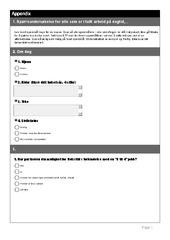| dc.contributor.advisor | Dahl, Tove Irene | |
| dc.contributor.author | Stenvold, Linda Catrine | |
| dc.date.accessioned | 2016-01-05T13:57:31Z | |
| dc.date.available | 2016-01-05T13:57:31Z | |
| dc.date.issued | 2012-05-02 | |
| dc.description.abstract | The current study aimed to investigate earlier reported connections to the morningness- eveningness dimension or flextime, and to offer an explanatory model linking these variables to well-being and productivity. Earlier findings gave the impression that it could be beneficial for both organizations and employees to have work schedules allowing employees to take their own circadian rhythm into account when planning their work day, since well-rested employees have been shown to be happier and more productive (Gaultney & CollinsMcNeil, 2009). Earlier studies on flextime have not, however, divided between morning- and evening-types when looking at effects – a gap the current study addressed. Employees (N = 246) working in Norwegian organizations participated in a survey, and answered a questionnaire especially designed for this study. Results showed that Evening-types and Morning-types differentiate on sleep-need and ideal work day start. Results also showed that respondents with- and respondents without flextime possibilities differentiated on experienced stress and deviation between ideal and real start of the work day. By analyzing three different models to explain links among people’s sleep patterns, flextime options at work, their well-being and productivity with Structural Equation Modeling, results showed productivity (in particular quality of work) were through variables connected to both flextime and circadian rhythm.
Keywords: morningness-eveningness, circadian rhythm, flextime, job satisfaction, sleepiness, well-being, work day | en_US |
| dc.identifier.uri | https://hdl.handle.net/10037/8350 | |
| dc.identifier.urn | URN:NBN:no-uit_munin_7919 | |
| dc.language.iso | eng | en_US |
| dc.publisher | Universitetet i Tromsø | en_US |
| dc.publisher | University of Tromsø | en_US |
| dc.rights.accessRights | openAccess | |
| dc.rights.holder | Copyright 2012 The Author(s) | |
| dc.rights.uri | https://creativecommons.org/licenses/by-nc-sa/3.0 | en_US |
| dc.rights | Attribution-NonCommercial-ShareAlike 3.0 Unported (CC BY-NC-SA 3.0) | en_US |
| dc.subject.courseID | PSY-3900 | en_US |
| dc.subject | VDP::Samfunnsvitenskap: 200::Psykologi: 260::Sosial- og arbeidspsykologi: 263 | en_US |
| dc.subject | VDP::Social science: 200::Psychology: 260::Social and occupational psychology: 263 | en_US |
| dc.subject | VDP::Samfunnsvitenskap: 200::Psykologi: 260::Organisasjonspsykologi: 268 | en_US |
| dc.subject | VDP::Social science: 200::Psychology: 260::Organizational psychology: 268 | en_US |
| dc.title | Morningness-Eveningness and Flextime Possibilities: Connections Between Circadian Rhythm, Work Day Schedule, Well-Being and Productivity | en_US |
| dc.type | Master thesis | en_US |
| dc.type | Mastergradsoppgave | en_US |


 English
English norsk
norsk

